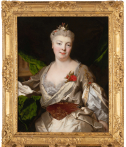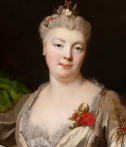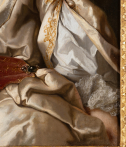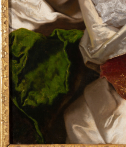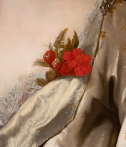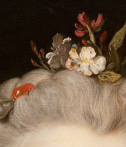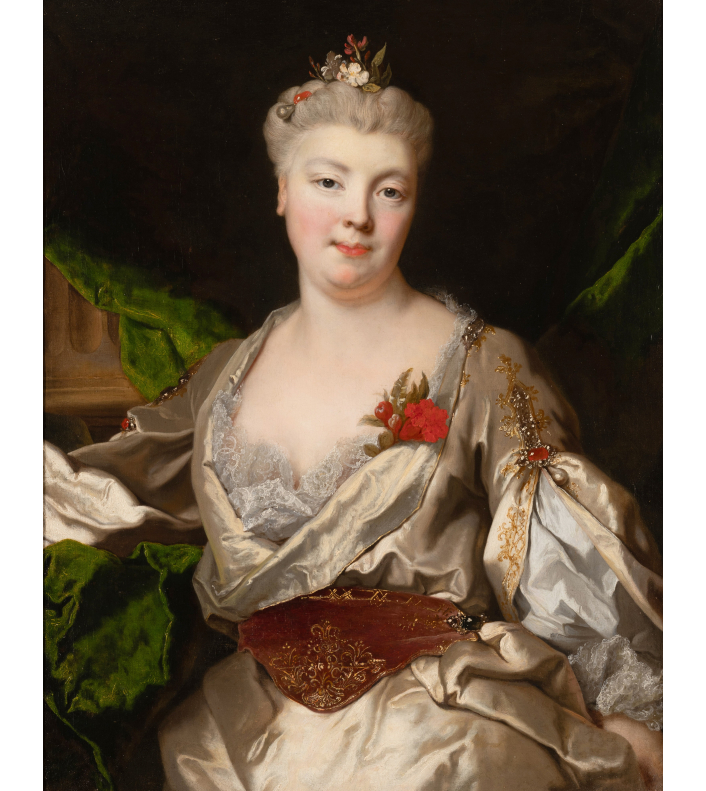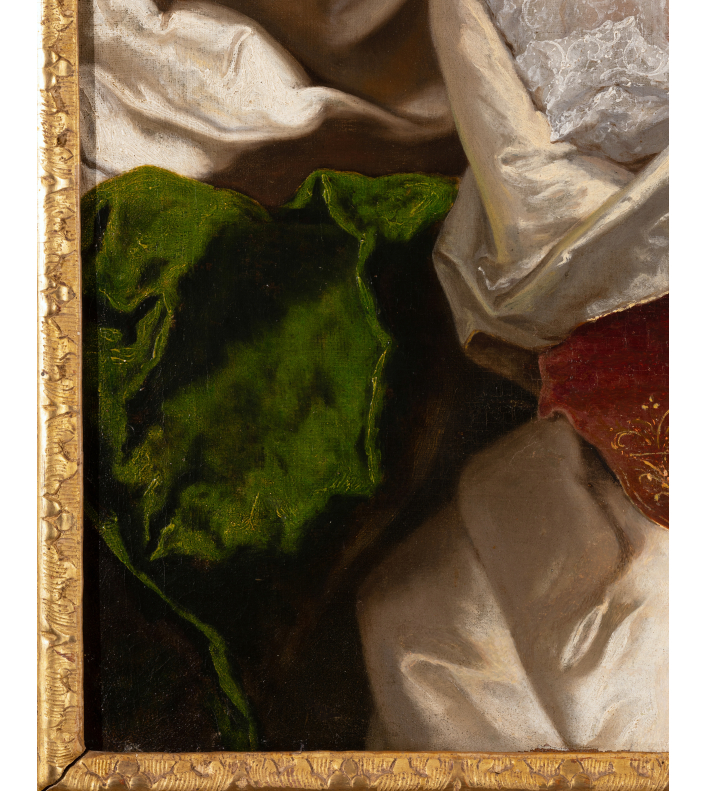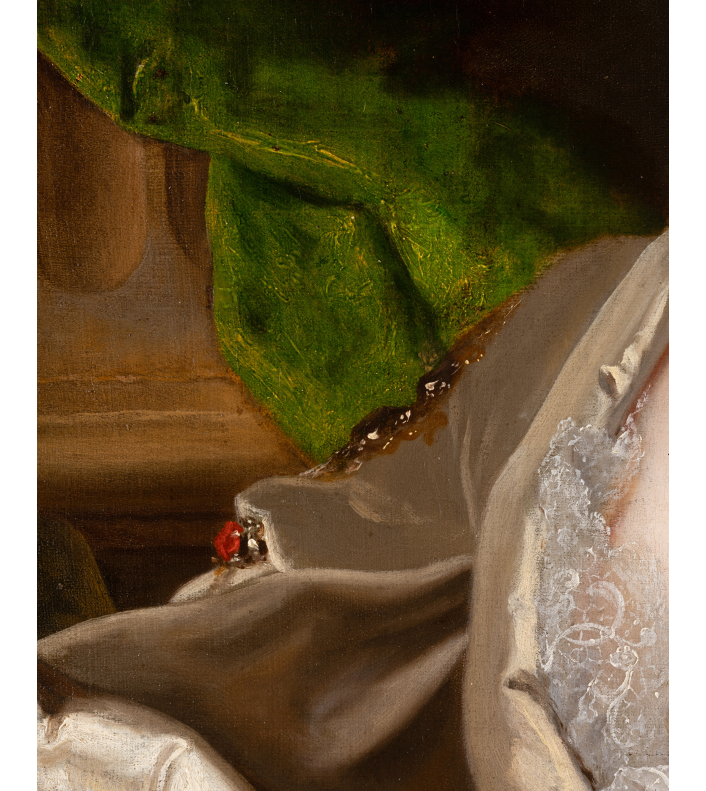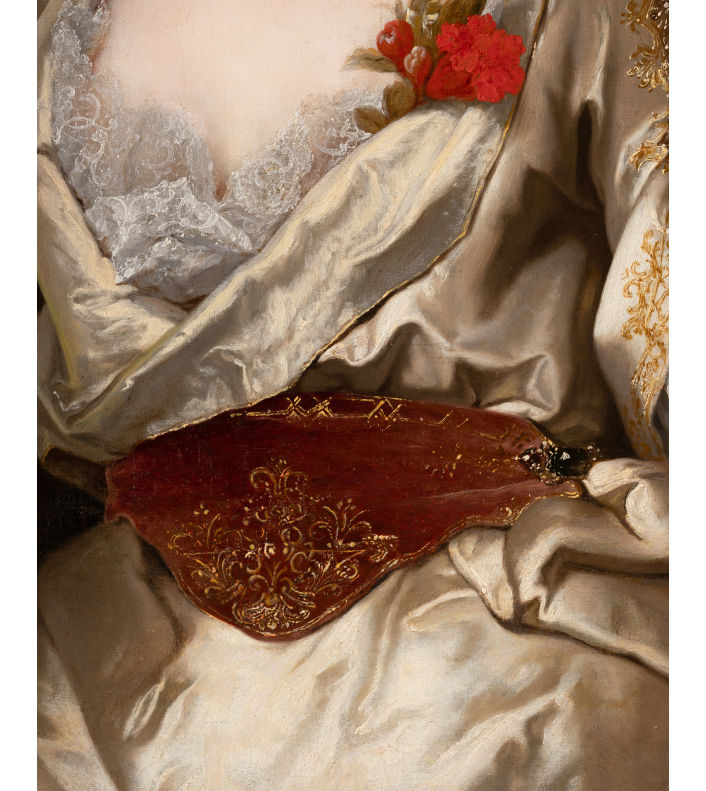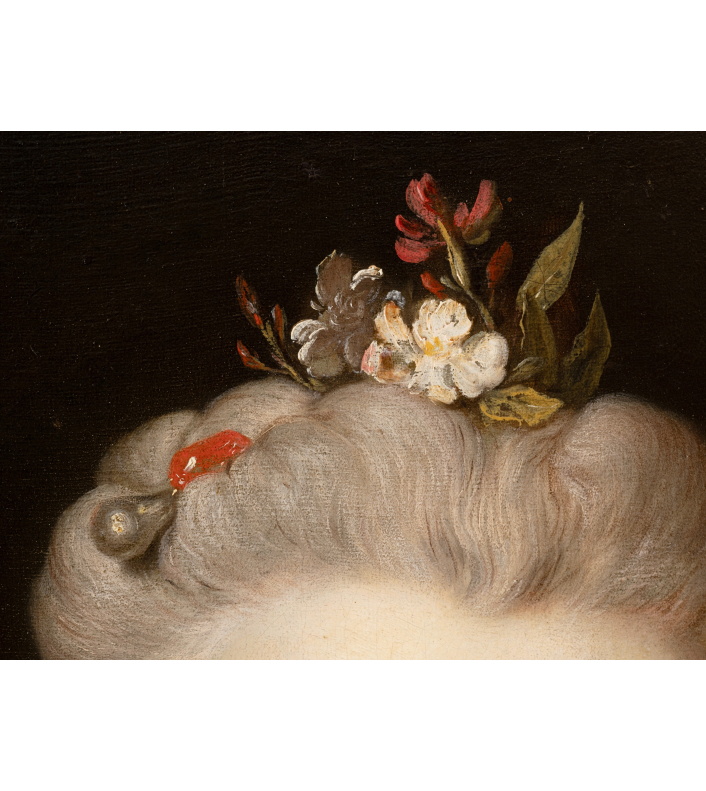Portrait of Judith Guiguer, Baronne de Prangins
by Nicolas de Largillièrre (Paris, 1656-1746)
Paris, early 18th century, circa 1715
Oil on canvas: h. 80 cm, w. 63 cm
Louis XIV period giltwood frame
Framed: h. 100 cm, w. 83 cm
We're grateful to Mr. Dominique Brême, former director of the museum of the Domaine départemental de Sceaux and specialist of Nicolas de Largillièrre, for kindly confirming the attribution by a visual examination of this portrait which he dates around 1715 and which he will include in the catalogue raisonné of the artist currently being prepared.
Our portrait is an autograph version, with variations, of a half-length portrait of the Baronne de Prangins, painted by Largillière around 1713 (see "Related Works"). In this large portrait, the Baroness's hair is styled in the Fontanges style, a fashion in vogue since the late 17th century.
The gradual disappearance of the "cruches" (small curls framing the forehead) in favor of a hairstyle that reveals the forehead circa 1715 likely prompted the young woman to commission a new version of her portrait so that Nicolas de Largillière could immortalize her in keeping with the new style of the time.
In a palatial setting that ostentatiously displays the sitter's wealth, the young woman is portrayed against a backdrop of a wide green velvet drape.
Gazing directly at the viewer, her strikingly bright black eyes animate her pale, milky complexion, contrasting with her lightly rouged cheeks and red lips.
Her powdered hair, gathered into a low chignon, is a more understated and natural hairstyle, a departure from the high bouffants of the late 17th century. A few flowers are tucked into the crown of her head, and a large pearl attached to a red ruby sparkles brilliantly, echoing the jewels adorning her slit sleeves.
Her cool-toned, cream-colored satin dress only serves to accentuate the pearly sheen of her throat. The mass of finely drawn lace on her blouse delicately conceals her breasts, while a large red carnation tucked into her décolletage draws the viewer's eye with its contrast against the whiteness of her complexion. Her waist is cinched by a corset of amaranth velvet embroidered with gold, fastened with gemstone clasps. The rolled-up, slit sleeves reveal her white blouse.
With his customary ease, Nicolas de Largillierre composes the volumes of the fabrics by playing with textures: the metallic sheen of the satin is magnified by the crisp, stiff folds, while the golden shimmer ignites the crests of the green velvet. His energetic and confident brushstrokes, his perfect understanding of how each material interacts with light, result in a breathtaking, lifelike rendering.
Related works:
• Nicolas de Largillierre, Portrait of the Baroness de Prangins, h. 140 cm, w. 110 cm, circa 1713,
Swiss National Museum, Château de Prangins, formerly in the collection of the Metropolitan Museum of Art, New York (between 1921 and 1983), pendant to the portrait of the Baron de Prangins, also held at Château de Prangins.
• Nicolas de Largillierre, Portrait of the Baroness de Prangins, h. 80 cm, w. 64 cm, Paul Cailleux Collection (1884–1964), loaned for the Nicolas de Largillierre exhibition, Grand Palais, Paris, 1928, number 81, acquired by the Cairo School of Fine Arts (Egypt) before 1930 (published without mentioning the Cailleux provenance in the Gazette des Beaux-Arts, volume 8, June 1930).
Judith Guiguer, baronne de Prangins, born Van Robais (Abbeville, 1694 – Paris, 1748) came from a family of Flemish descent. Following an invitation from Jean-Baptiste Colbert, her grandfather, Josse van Robais (1630–1685), originally from Kortrijk, settled in Abbeville in 1665 to establish a fine cloth manufactory, which was granted the title of royal manufactory. His son, Josse Van Robais (1662–1733), became the manufactory's director and continued the family business. In 1713, Judith Van Robais married Louis Guiguer (Lyon, 1675 – Paris, 1747), a Parisian banker of Swiss origin, who founded the Tourton and Guiguer bank in 1703. He amassed his fortune through Law's system of financial transactions and the commercial operations of the French East India Company. Seeking a title of nobility to add to his immense fortune, Louis Guiguer acquired the barony of Prangins, located on Lake Geneva, and had a château built there. The Guiguers, however, did not live in the château, preferring to remain in Paris given Louis Guiguer's financial activities.
During the Regency period, a quatrain circulated about the Baroness of Prangins, which greatly amused the courtiers on the occasion of Peter the Great of Russia's visit to Paris in 1717, when he was said to have been captivated by the young woman's charms.
The Tsar likes strong women;
if Prangins does not displease him,
it is because her opulent charms
have great difficulty passing through the gates.
Nicolas de Largillièrre (Paris, 1656-1746)
Nicolas de Largillièrre, born on October 2, 1656, in Paris, where he died on March 20, 1746, was a French painter. Of Flemish origin, although born in Paris, he spent his childhood in Antwerp, apprenticed to the landscape painter Antoine Goubau. In 1673, he went to England where he worked as an assistant in the studio of the portrait painter Peter Lely for several years. In London, Largillière discovered the art of portraiture and absorbed the valuable lessons of the British successor to Anthony van Dyck. Upon his return to France, he was accepted into the Royal Academy in 1683 and, three years later, was admitted as a "portrait and history painter" upon presentation of his Portrait of Charles Le Brun.
He is one of the most renowned portrait painters of the 17th and 18th centuries. Nicolas de Largillière's long career spanned the reigns of Louis XIV and Louis XV, during which he established himself as a leading portraitist. His female portraits, in particular, are striking for their introspective nature and decorative richness.
Bibliography: Dominique Brême, Nicolas de Largillierre , 1656-1746, exh. cat. Paris, Musée Jacquemart-André, Paris, Phileas Fogg editions, 2003


